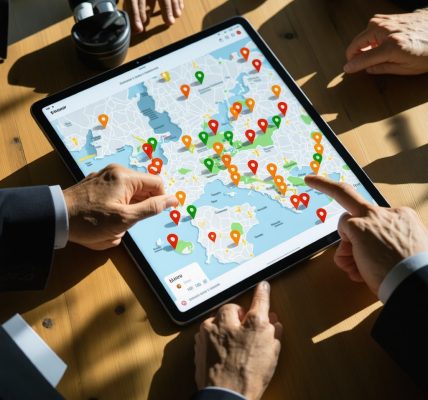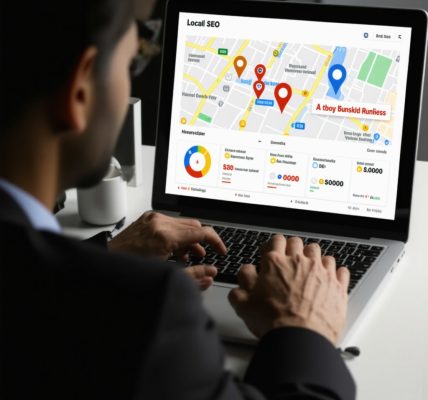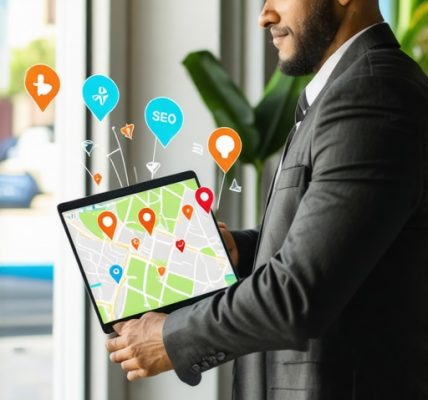Captivating Your Local Audience: The Art of GMB Business Descriptions
In the evolving landscape of digital marketing, optimizing your Google My Business (GMB) profile with strategically crafted business descriptions is paramount for capturing local traffic. A well-optimized GMB description not only communicates your brand’s unique value but also significantly influences your local search visibility. Today, we dive deep into how refined keywords and semantic SEO techniques can transform your GMB description into a powerful local traffic magnet.
Beyond Keywords: Weaving a Narrative That Resonates Locally
Effective GMB business descriptions transcend merely inserting keywords; they craft an evocative narrative that aligns with the local community’s needs and search intents. By seamlessly integrating Latent Semantic Indexing (LSI) keywords related to your services and locality, you create a rich semantic context that search engines recognize as authoritative and relevant. For example, a neighborhood bakery might include phrases like “fresh artisan bread in Downtown Seattle” or “organic pastries near Pike Place Market,” enhancing local relevance.
The Power of Specificity: Tailoring Descriptions to Local Search Queries
Local search algorithms prioritize specificity and relevance. Embedding geographic modifiers and service-specific keywords within your GMB description amplifies your profile’s chances of appearing in “near me” searches and localized queries. This approach ensures that your business speaks directly to the audience searching within your vicinity, thereby increasing the quality and conversion potential of local traffic.
How Can You Balance Keyword Optimization Without Overstuffing?
Striking the optimal balance between keyword inclusion and natural readability is an expert skill. Overstuffing keywords can trigger search engine penalties and alienate potential customers. Instead, focus on incorporating keywords organically within compelling sentences that underline your business strengths and local appeal. Employ synonyms and related terms to enrich the text semantically. For instance, instead of repeating “local auto repair,” alternate with “neighborhood car service” or “trusted vehicle maintenance in [City].” Such diversity enhances SEO while maintaining engaging content.
Experience Speaks: Real-World Impact of Optimized GMB Descriptions
Consider a local dental clinic that revamped its GMB description by highlighting key services alongside geographic cues. Within weeks, they observed a notable surge in appointment requests originating from Google Maps and local search results. This tangible outcome underscores the importance of expert-crafted descriptions that align with both user intent and search engine algorithms. The clinic’s story exemplifies how precision and expertise in description writing can directly translate into measurable local business growth.
Elevate Your Local SEO Game: Integrate Citation and Review Strategies
Optimizing your GMB description is a foundational step, but coupling it with expert citation management and proactive review generation magnifies your local SEO impact. Consistent citations across authoritative local directories and soliciting authentic customer reviews build trust and authority, further boosting your local rankings. For comprehensive tactics on citation services, explore expert GMB citation services for enhanced rankings that complement your description strategy.
Unlock the full potential of your Google Business profile by diving deeper into optimization strategies and local SEO mastery at Mastering Google Business SEO: Your Complete Guide.
If you found these insights valuable, share your thoughts or questions below to join the conversation on optimizing GMB profiles for local dominance.
According to Moz, local search signals such as proximity, relevance, and prominence are critical ranking factors, which underscores the necessity of tailored descriptions in GMB profiles (Moz Local SEO Guide).
Finding the Voice That Speaks to Your Community
One of the lessons I learned early on in optimizing GMB descriptions is that your profile should sound like a neighbor talking to a neighbor, not a faceless corporation. When I helped a local coffee shop revamp their description, we focused on storytelling — mentioning their passion for ethically sourced beans and their cozy spot near the city library where locals love to unwind. This approach made the description both keyword-rich and genuinely engaging.
It’s about striking a balance between SEO and personality. Your business description is often the first impression potential customers get, so infusing it with authentic warmth can make all the difference. This blend is at the heart of effective local SEO, and it’s what transforms casual searchers into loyal patrons.
Leveraging Semantic SEO Tools for Deeper Optimization
Semantic SEO isn’t just jargon — it’s a practical toolkit. Using tools that analyze LSI keywords and related search queries helped me uncover phrases I wouldn’t have thought to include otherwise. For instance, when optimizing a local landscaping company’s GMB, I discovered terms like “seasonal garden care” and “eco-friendly lawn services” resonated strongly within their community. Integrating these enriched their description’s relevance without sounding forced.
For those curious about semantic analysis tools, resources like Moz’s Semantic Search Guide provide excellent insights into how search engines interpret meaning beyond exact keywords. Applying these insights can elevate your GMB profile from basic to standout.
Ever Wondered How to Keep Your GMB Description Fresh and Effective Over Time?
It’s a great question because search trends and local interests evolve. I recommend revisiting your GMB description every quarter. Look at your Google Insights data to see which search terms are driving traffic and adjust your description accordingly. Maybe a new neighborhood event has become a hot topic, or a service you offer is gaining popularity. Updating your description with these timely details keeps your profile relevant and can boost your local ranking.
Also, pairing description updates with fresh photos and new posts on your GMB can amplify this effect, signaling to Google that your business is active and engaged. This holistic approach is something I’ve seen work repeatedly in increasing local visibility.
Integrating Reviews and Citations: Your Local SEO Power Couple
While crafting a compelling description is crucial, I’ve found that coupling it with a solid citation strategy and active review management truly transforms your local SEO results. Consistency across local directories ensures Google trusts your business information, while positive reviews build credibility with both the algorithm and potential customers.
If you want to dive deeper, check out this guide on GMB review generation best practices to complement your description efforts. Taking this combined approach has been a game changer in my projects, helping businesses secure top spots in the Google 3-Pack.
How about you? Have you experimented with updating your GMB description or integrated reviews and citations in your local SEO strategy? Share your experiences or questions below — I’d love to hear what’s worked for you or help troubleshoot challenges you might be facing.
Harnessing the Nuances of Geo-Contextual Keyword Clustering for Superior Local Ranking
To truly master Google My Business description optimization, an expert-level tactic involves geo-contextual keyword clustering. This means grouping related keywords not only by service but also by hyper-local geographic signals to create a layered semantic map. For example, a landscaping company in Austin might cluster terms like “sustainable garden design in East Austin,” “seasonal lawn care near Zilker Park,” and “eco-friendly yard services downtown Austin.” This clustering signals to search engines a deep, multifaceted local relevance beyond simple keyword insertion.
Implementing this strategy requires advanced SEO tools that analyze local search volumes and semantic relationships, such as Ahrefs or SEMrush’s Keyword Magic Tool combined with specialized local SEO platforms like BrightLocal. By doing so, businesses can uncover niche local queries that competitors might overlook, gaining a powerful edge in localized search visibility.
What Role Does User Intent Play in Crafting GMB Business Descriptions?
User intent is critical in shaping descriptions that convert. Understanding whether potential customers are searching for informational content, transactional services, or navigational queries allows the business description to be tailored accordingly. For example, a plumbing company might emphasize “emergency plumbing services with 24/7 availability” to target urgent transactional intent, while also including “expert advice on water heater maintenance” to capture informational searches.
Aligning the description with clear user intent enhances engagement metrics such as click-through rates and time on profile, which are indirect signals Google uses to rank local businesses higher. Therefore, integrating calls-to-action that resonate with specific user intents — like “Call now for a free estimate” or “Visit our showroom in downtown” — can significantly improve conversion efficiency.
For a comprehensive framework on mapping user intent in local SEO, see Search Engine Journal’s authoritative guide on Local SEO User Intent Optimization.
Semantic Richness: Leveraging NLP Insights to Future-Proof Your GMB Description
Natural Language Processing (NLP) advancements in search algorithms necessitate descriptions that embrace semantic richness and contextual coherence. Using entities, synonyms, and related concepts within your GMB description enhances the profile’s ability to appear in diverse but relevant search queries.
For instance, instead of solely stating “Italian restaurant in Boston,” integrating phrases like “authentic Neapolitan pizza,” “fine dining in the North End,” and “family-owned Italian eatery” provides layered semantic cues. This multidimensional approach improves the chances of appearing in voice search results and featured snippets — areas of increasing importance in local search.
To apply these techniques, tools like Google’s Natural Language API or IBM Watson can analyze your description’s semantic depth, helping you iteratively refine content to match evolving search algorithm sophistication.
Maximizing Engagement with Dynamic Content Updates and GMB Post Integration
Beyond static descriptions, regularly updating your GMB profile with dynamic content such as posts, offers, and event announcements reinforces your business’s local authority and signals activity to Google. Combining these updates with a well-crafted description creates a synergistic effect that elevates local rankings and user engagement.
For example, a fitness studio could complement its optimized description with weekly posts about new classes, seasonal promotions, or community fitness events. These elements not only attract repeat visits to your profile but also build a narrative of an active, community-focused business.
This strategy aligns with Google’s emphasis on fresh content and user engagement as ranking factors in local search algorithms.
Curious about how these advanced strategies can transform your Google My Business presence? Explore our in-depth resources or consult with our local SEO experts to tailor a roadmap for your business’s unique needs.
Harnessing AI-Powered Semantic Optimization for GMB Descriptions
As search engines evolve, leveraging artificial intelligence and machine learning insights can elevate your Google My Business description beyond traditional keyword tactics. By utilizing AI-driven semantic analysis tools, you can pinpoint emerging local search trends and dynamically tailor your descriptions to match nuanced user intent patterns. This level of sophistication ensures your profile remains competitive in hyper-localized search ecosystems.
How Can AI and Machine Learning Enhance the Precision of GMB Descriptions?
AI-powered platforms analyze vast datasets, including local search queries, competitor profiles, and consumer behavior, to recommend semantically rich keyword clusters and content structures. These insights enable businesses to craft descriptions that resonate deeply with user intent, improve click-through rates, and reduce bounce rates. For instance, Google’s BERT and MUM models understand context and intent better than ever, making semantic relevance paramount.
Incorporating AI tools like Clearscope or SurferSEO can provide actionable recommendations on keyword density, semantic breadth, and readability, ensuring your GMB description aligns with the latest algorithmic expectations.
Implementing Structured Data to Signal Local Relevance and Enhance SERP Features
Structured data markup, specifically LocalBusiness schema, can be embedded in your website to complement your GMB profile and reinforce local relevance signals. While GMB descriptions themselves do not support markup, ensuring your website utilizes schema to highlight address, opening hours, and service areas creates a cohesive local SEO ecosystem.
This integration boosts your chances of appearing in rich snippets, knowledge panels, and voice search results, amplifying exposure and credibility.
Advanced Link-Building Tactics to Amplify GMB Description Authority
Elevating your Google My Business profile’s authority involves cultivating high-quality backlinks from reputable local sources such as chambers of commerce, local news outlets, and industry-specific directories. These citations complement your optimized description by signaling prominence and trustworthiness to search engines.
Combining authoritative backlinks with a semantically rich GMB description creates a synergistic effect that propels your local rankings above competitors who rely solely on keyword stuffing or generic profiles.
For detailed strategies on authoritative local link acquisition, consult Ahrefs’ Local SEO Link Building Guide, an industry-leading resource recognized for practical, data-driven insights.
Crafting Multi-Channel Content Synergies to Maximize Local Engagement
Integrating your GMB description optimization with complementary content marketing efforts—such as localized blog posts, community event coverage, and targeted social media campaigns—creates a robust local brand presence. This multi-channel approach drives consistent traffic signals and user interaction, which Google interprets as relevance and authority.
By aligning messaging across platforms, you build a cohesive narrative that enhances the impact of your GMB description and fosters deeper community connections.
Optimizing for Voice Search: Future-Proofing Your GMB Description
With the rapid growth of voice-activated assistant usage, optimizing your GMB description for natural, conversational queries is crucial. Incorporating question phrases and long-tail keywords that mirror how people speak increases the likelihood of your business appearing in voice search results.
For example, instead of “best pizza Boston,” a voice-optimized description might include “Where can I find the best pizza near Boston Common?” This anticipates user queries and aligns with Google’s intent understanding.
Ready to harness these cutting-edge local SEO strategies? Connect with our expert team to customize a Google My Business optimization roadmap that elevates your local visibility and drives measurable growth.
Frequently Asked Questions (FAQ)
1. What exactly is a Google My Business (GMB) description, and why is it important for local SEO?
The GMB description is a concise summary of your business that appears on your Google My Business profile. It communicates your unique value proposition, services, and location to potential customers. Optimizing it with relevant keywords and local context helps improve visibility in local search results, driving more qualified traffic and enhancing engagement.
2. How can I effectively balance keyword optimization with natural, engaging language in my GMB description?
Effective balance is achieved by integrating keywords organically within compelling, conversational sentences that resonate with your local audience. Avoid keyword stuffing by using synonyms, LSI terms, and semantic variations. Focus on storytelling that reflects your brand personality while maintaining SEO relevance for maximum impact.
3. Why is incorporating Latent Semantic Indexing (LSI) keywords beneficial in GMB descriptions?
LSI keywords provide semantic context that helps search engines better understand the breadth and depth of your services and location relevance. Including closely related terms and phrases enriches your description’s meaning, expands reach across diverse search queries, and reduces reliance on repetitive exact-match keywords.
4. How often should I update my GMB description to maintain optimal performance?
It is advisable to review and refresh your GMB description quarterly or whenever significant changes occur in your services, community events, or local search trends. Using Google Insights data to identify trending keywords and user intents ensures your description stays relevant and continues to drive local engagement.
5. Can integrating reviews and citations really impact my GMB profile’s ranking?
Yes, reviews and citation consistency are vital local SEO signals. Authentic positive reviews build trust and credibility, while accurate citations across authoritative local directories reinforce your business’s prominence and relevance. Together with a well-crafted description, they significantly boost your profile’s ranking potential.
6. What role does user intent play when crafting a GMB description?
User intent guides the messaging and keyword selection within your description. Understanding whether searchers seek information, want to transact, or navigate to your location allows you to tailor content with targeted calls-to-action and service highlights that maximize conversion and engagement.
7. How can AI and machine learning tools enhance the optimization of GMB descriptions?
AI-powered semantic analysis tools help identify emerging local search patterns, recommend semantically rich keyword clusters, and optimize content readability and relevance. Leveraging these insights ensures your description aligns with sophisticated search algorithms like Google’s BERT and MUM, improving visibility and user experience.
8. Is optimizing my GMB description for voice search different from traditional SEO?
Yes, voice search optimization emphasizes natural, conversational language and question-based queries. Incorporating long-tail keywords and phrasing that mimic everyday speech increases the likelihood of appearing in voice assistant results and featured snippets, future-proofing your profile for evolving search behaviors.
9. How does geo-contextual keyword clustering improve local search rankings?
Geo-contextual keyword clustering organizes related terms by both service and hyper-local geographic references, signaling to search engines a nuanced local relevance. This layered semantic approach uncovers niche queries and enhances your profile’s authority within specific neighborhoods or districts, giving you a competitive edge.
10. Should I use structured data markup on my website to complement my GMB profile?
Absolutely. Implementing LocalBusiness schema markup on your website highlights critical local information such as address, hours, and service areas. While GMB descriptions don’t support markup, this structured data complements your profile, enhancing your chances of rich snippets and knowledge panel appearances.
Trusted External Sources
- Moz Local SEO Guide: An authoritative resource on local search ranking factors, offering deep insights into proximity, relevance, and prominence that influence GMB optimization strategies.
- Search Engine Journal – Local SEO User Intent Optimization: Provides a comprehensive framework for mapping user intent to local SEO tactics, crucial for crafting effective GMB descriptions.
- Ahrefs Local SEO Link Building Guide: A data-driven guide detailing strategies for acquiring authoritative local backlinks that enhance GMB profile prominence and trustworthiness.
- Google’s Natural Language API Documentation: Offers tools and methodologies for analyzing semantic richness and contextual relevance within content, supporting advanced semantic SEO practices.
- BrightLocal Local SEO Platform: Specialized in local SEO analytics and keyword research, ideal for implementing geo-contextual keyword clustering and citation management.
Conclusion: Elevate Your Local Presence with Expert GMB Description Optimization
Mastering the art of Google My Business description optimization is a multifaceted endeavor that blends strategic keyword integration, semantic SEO, user intent alignment, and authentic storytelling. By weaving geo-contextual keywords and LSI terms into a narrative that resonates with your local community, you create a profile that not only ranks prominently but also converts casual searchers into loyal customers.
Regularly updating your description with fresh insights, leveraging AI-powered tools, and complementing your profile with robust citation and review strategies amplify your local SEO impact. Embracing structured data and voice search optimization further future-proofs your presence in an evolving search landscape.
Implement these expert tactics to transform your GMB profile into a dynamic local marketing asset. Share your experiences, ask questions, and explore our comprehensive guides to continue refining your approach and dominate your local search ecosystem.





I found this post incredibly insightful, especially the emphasis on weaving genuine storytelling into GMB descriptions. In my experience managing local businesses, authenticity can truly set a profile apart. We once revamped a boutique’s GMB by highlighting their community involvement and unique history, which not only improved engagement but also resonated more with local customers. It made me wonder—how do others balance the need for keyword optimization with maintaining that authentic voice? Are there specific tools or tactics anyone has found useful for ensuring their description remains natural yet effective in SEO terms? It seems that blending semantic SEO with a personal touch really connects with the community, and I’d love to hear more examples or strategies from others who have succeeded in this area.
This post really highlights how powerful a well-crafted GMB business description can be in attracting local customers. I’ve seen firsthand how adding geographic-specific keywords like “near Central Park” or “serving Brooklyn residents” can drastically improve visibility in local searches. But I also agree that the storytelling aspect makes a huge difference—creating a compelling narrative that resonates with the community fosters loyalty and trust. I particularly appreciate the mention of semantic SEO tools like Moz and SurferSEO; they’ve helped me find related LSI keywords that I wouldn’t have considered organically. For businesses just starting out, balancing keyword optimization with genuine language can be tricky. Has anyone tried using AI writing assistants or semantic analysis tools to help craft descriptions that sound natural but are optimized for search? It seems like integrating these technologies could streamline the process and yield better engagement. Would love to hear about your experiences or recommendations on maintaining authenticity while maximizing SEO impact.
This post really hits home for me, especially the emphasis on weaving storytelling into GMB descriptions. I’ve noticed that when I focus solely on keyword stuffing, the description starts to feel unnatural, which can turn potential customers off. Using tools like Semrush or Moz to analyze relevant LSI keywords has helped me find a balance, embedding keywords organically into a compelling narrative about our local bakery. For instance, highlighting our organic ingredients and community involvement alongside geo-specific terms has made a noticeable difference in local search visibility. I wonder, what are some effective ways to ensure the description remains fresh and engaging over time, especially when trends or services evolve? Do others find that regularly revisiting and updating the description, combined with active review management, helps maintain consistency? I’d be interested to hear how you all approach striking that perfect balance between SEO and authenticity in your descriptions.